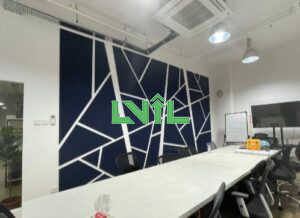How to Choose the Best Sound Absorbing Panels for Your Needs
 https://www.lvildiy.com/
https://www.lvildiy.com/
Understanding the Purpose of Sound Absorption
Before delving into the specifics of different panels, it is crucial to define the acoustic goals for your space. Are you aiming to mitigate echoes in a cavernous room, enhance sound precision in a recording studio, or cultivate a quieter workspace? The objective of sound absorption—whether reducing reverberation, improving speech intelligibility, or minimizing noise transfer—will directly inform the type and quantity of panels required. Copyright Shandong Unique International Trade Co.,Ltd
- Recording Studios: Prioritize panels that dampen reverberation and refine sound clarity, especially for vocal and instrumental performances.
- Home Theatres: Opt for solutions that absorb extraneous sounds and reduce echoes to create a immersive audio environment.
- Offices & Meeting Rooms: Focus on panels that curtail distracting noise and enhance speech clarity for effective communication.
- Residential Spaces: Choose panels to minimize sound transfer between rooms or floors, elevating overall living comfort.
Evaluating Panel Materials
Sound-absorbing panels are crafted from diverse materials, each with unique acoustic properties and aesthetic profiles. Your choice should align with the sound frequencies you aim to control and the design of your space:
Shandong Unique International Trade Co.,Ltd
- Fibreglass Panels: Renowned for absorbing mid- to high-frequency sounds, these are ideal for recording studios and home theatres. Wrapped in fabric with customizable colours and textures, they blend seamlessly with interior decor.
- Foam Panels: Lightweight and easy to install, these are popular in commercial and residential settings, effectively reducing echoes and high-frequency noise. However, they may underperform with low-frequency sounds.
- Mineral Wool Panels: Celebrated for broad-spectrum sound absorption across all frequencies, these excel in industrial environments, large rooms, or spaces requiring robust noise reduction.
- Wood Panels: Merging acoustic functionality with visual appeal, these are often used in high-end home theatres or commercial spaces. They absorb mid- to high-frequency sounds and can be paired with other materials for enhanced performance.
Impact of Thickness and Density
Panel thickness and density are pivotal in determining absorption efficiency:
Unique
- Thin Panels (1–2 inches): Best suited for high-frequency noise like echoes and reverb, ideal for improving speech clarity in offices or small rooms.
- Medium-Thickness Panels (2–4 inches): Offer balanced absorption of mid- to high-frequency sounds, making them versatile for recording studios, home theatres, and residential areas.
- Thick Panels (4+ inches): Essential for tackling low-frequency noise, such as bass, these are critical in music studios or spaces with prominent low-end audio.
Aesthetics and Design Integration
While functionality is paramount, the visual appeal of panels matters, especially in residential or commercial settings. Modern options offer versatility:
- Fabric-Wrapped Panels: Available in various colours and textures, these are customizable to match existing decor, blending seamlessly into aesthetic-focused spaces.
- Art Panels: Doubling as decorative elements, these feature printed designs or artwork, making them ideal for offices, waiting areas, or homes where visual appeal is prioritized.
- Perforated Wood Panels: Combining natural elegance with acoustic benefits, these are often used in upscale environments like theatres, conference rooms, or luxury residences.
Installation Flexibility
Ease of installation should align with your needs:
Unique
- Adhesive Panels: Lightweight options like foam panels with peel-and-stick backing allow for quick DIY setup, perfect for temporary or adjustable configurations.
- Mountable Panels: Heavier materials such as fibreglass or wood require wall mounts or brackets, offering a secure, permanent solution (professional installation may be recommended).
- Free-Standing Panels: Provides flexibility for dynamic spaces like open-plan offices or studios, allowing easy repositioning as acoustic needs evolve.
Budget and Long-Term Value
Balancing cost and performance is key: www.lvildiy.com
- Quality Over Quantity: Investing in high-performance panels often yields better results than cheaper alternatives, as fewer premium panels can outperform numerous low-quality ones.
- Durability as an Investment: High-quality panels offer longevity and sustained effectiveness, enhancing the long-term comfort and functionality of your space.
- Customization Options: For those with flexible budgets, bespoke panels can be tailored to meet specific acoustic and design requirements.
Testing and Optimization
After installation, evaluate performance to ensure goals are met: Shandong Unique International Trade Co.,Ltd
- Clap Test: Assess echo reduction by clapping in various room areas—minimal echo indicates effective absorption.
- Sound Source Evaluation: Play audio and move through the space, noting sound quality changes to identify areas needing adjustment.
- Iterative Adjustment: Add or reposition panels as needed to address persistent acoustic issues.
Conclusion
Selecting the right sound-absorbing panels requires a strategic blend of understanding your space’s unique needs, material and design considerations, and balancing performance with budget. By thoughtfully evaluating options and testing results, you can create an acoustic solution that not only enhances sound quality but also elevates the comfort and functionality of your environment—whether in a professional studio, home theatre, or everyday living space. The right panels are the cornerstone of a thoughtfully designed, acoustically optimized space.

